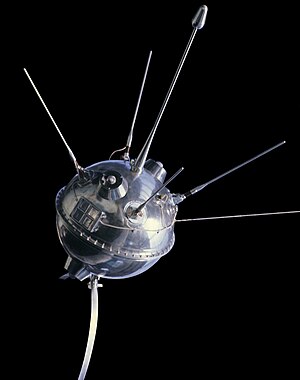Lunik 1
| Luna 1 | ||||||||||
|---|---|---|---|---|---|---|---|---|---|---|
 Luna 1 |
||||||||||
| NSSDC ID | 1959-012A | |||||||||
| Mission goal | Earth moon | |||||||||
| Client |
|
|||||||||
| Launcher | Vostok (8K72) | |||||||||
| construction | ||||||||||
| Takeoff mass | 361.3 kg | |||||||||
| Course of the mission | ||||||||||
| Start date | January 2, 1959, 16:41 UTC | |||||||||
| launch pad | Baikonur Cosmodrome | |||||||||
| End date | 5th January 1959 | |||||||||
|
||||||||||
Luna 1 ( Russian Луна-1 , Luna-1 , Metschta ), also Lunik 1 , was the first lunar probe in the world and the first space probe ever. The planned goal of the mission, the impact on the moon , was not achieved. Instead, on January 4, 1959, it unintentionally became the first flyby probe .
The series name Lunik was created immediately after the start of Lunik 1 and only in the western media, based on the Russian name Sputnik for the first artificial earth satellites. There it replaced the original name Metschta ( Russian Мечта for dream ). In the official Soviet media, Lunik 1 was called the Cosmic Rocket . Later the series of three Lunik probes was often assigned to the subsequent Luna series and Lunik 1 was referred to as Luna 1 .
construction
The spherical probe had a mass of 361.3 kg and a diameter of 1.45 m. The hermetically sealed device container was made of an aluminum - magnesium alloy and was filled with nitrogen . The gas helped to maintain the necessary operating temperature for the electronic devices. The sensors for the measuring devices, a rod boom with a magnetometer and four rod antennas were attached to the outer surface of the container . The measuring devices were intended for the investigation of radiation and magnetic fields in the vicinity of the earth and moon, as well as for the determination of the density of the interplanetary gas. The internal devices also included a Geiger counter and a scintillation counter . Lunik 1 also carried massive metal balls that would have survived the impact on the moon and that contained Soviet emblems such as hammer and sickle . A camera for pictures of the surface of the moon was not on board. The electricity supply was provided by mercury oxide batteries and silver-zinc batteries. The probe had no possibility of course correction.
The probe transmitted in the ranges 19.993 MHz, 183.6 MHz ( tracking ) and 70.2 MHz. 4 whip antennas and a rigid antenna were provided directly on the housing for transmission .
Flight history
After the false starts of three predecessors in 1958 and only 15 months after the start of Sputnik 1 , Lunik 1 took off for the moon on January 2, 1959 from the Baikonur spaceport . Its early Vostok- type 8K72 - called Luna - launch vehicle was an R-7 extended by a third stage for moon flight , which was already used in the three preliminary tests and was developed as the world's first ICBM.
On January 3rd at 00:56 UTC, well before reaching the moon, a sodium vapor cloud was ejected at a distance of about 113,000 km from the separated last rocket stage . The amount of 1 kg sodium used resulted in a cloud that was stimulated to glow orange by the solar wind and which could be photographed as an "artificial comet " to visibly mark the orbit position from observation stations. When it was then recognized that the probe would miss the moon and have to leave the earth-moon system, it was renamed Metschta, based on the dream of mankind to advance into deeper space.
Due to a speed that was too high, Lunik 1 missed the surface of the Earth's satellite on January 4th at 02:59 UTC after 34 hours by almost 6000 km and flew past it at a speed of 2.5 km / s. As a result of this unplanned swing-by , it entered an orbit around the sun between the orbits of Earth and Mars , which received a numerical eccentricity of 0.14767, with a perihelion at 0.9766 AU and an aphelion at 1.315 AU, and an orbital inclination of 0.01 ° and a period of rotation of 450 days.
The last radio signals from the probe could still be received from a distance of around 600,000 km until its batteries were exhausted on January 5, 1959 at around 7:00 UTC.
Results
Lunik 1 missed its mission goal, but, as planned, sent a lot of information to Earth, which was recorded by its highly sensitive measuring devices. It provided measurements of the Earth's Van Allen radiation belt , confirmed the existence of the solar wind and measured it at a speed of 400 km / s. She also discovered that the moon has no magnetic field.
The very similar successor probe Lunik 2 reached the surface of the moon in the same year.
See also
- Chronology of the moon missions
- Race into space
- Unmanned space travel records
- Soviet space travel
- Space exploration timeline
Web links
- Lunik 1 in the NSSDCA Master Catalog (English)
- The Mission of Luna 1 ( Memento from October 3, 2009 in the Internet Archive )
- The Luna program at bernd-leitenberger.de